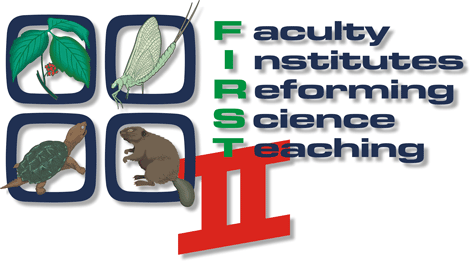
The Hancock Biological Station at Murray State University
is one of five national field stations participating in the Faculty
Insitutes for Reform
in Science Teaching
II sponsored by the National Science
Foundation.
Teams from five regional academic institutions have been selected to
participate in a series of workshops for implementing inquiry-based
teaching in their science courses and initiating undergraduate curriculum
reform.
![]()
![]()
![]()
![]()
![]()
![]()
![]()
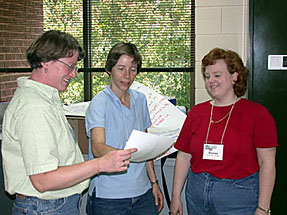
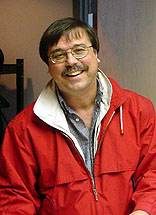

Left to Right:: Jill Kruper,
Terry Derting, Renee Fister, John Mateja amd Travis Brown, Workshop
Assistant
Participants:
-
Terry Derting
-
E-mail: terry.derting@murraystate.edu
-
Renee Fister
-
E-mail: kfister.math.mursuky.edu
-
Jill Kruper
-
E-mail: jill.kruper@murraystate.edu
-
John Mateja
-
E-mail: john.mateja@murraystate.edu
Biographies:
Terry L. Derting
I am a professor in the Department of
Biological Sciences at Murray State University (MSU). I obtained an
M.S. degree from VA Polytechnic Institute and a Ph.D. from Indiana University.
My research training is in the area of physiological ecology, primarily
with small mammals. My research interests include energetics, effects
of habitat fragmentation on the physiology and fitness of small mammals,
and curriculum development. I have been employed at Murray State University
for nine years during which I have served as the advisor for the Secondary
Education in Biology program. My teaching experiences include human
and animal physiology, human and comparative anatomy, embryology, developmental
biology, histology, genetics, mammalogy, field ecology (in Belize and
Ecuador), and physiological ecology. My interest in improved teaching
and curriculum development began with my work on the BioQUEST project
at Beloit College, WI. Through BioQUEST I became involved in the development
of methods to enhance active learning by students. At MSU I have helped
to develop and implement an inter-disciplinary science course, based
on the National Education Standards, for elementary and middle school
education majors (CHE/Eisenhower Foundation). Currently I am leading
a project to revise our introductory biology program for majors through
implementation of inquiry-based courses (NSF-CCLI A&I). I am also
participating in the Pre-College Outreach component of our Howard Hughes
Medical Institute project that involves collaborations between university
faculty and local high school teachers. Teaching through research also
plays a significant role in my professional activities. I regularly
mentor undergraduate and graduate research students. I am active nationally
as a member of the American Society of Mammalogists, the Association
for College and University Biology Educators, the Council on Undergraduate
Research, and the BioQUEST Curriculum Consortium.
Jill Kruper
I have a bachelor's degree in Biology
from Hollins College, VA and Master's degree in Environmental Biology
from Hood College, MD. I am currently finishing a Ph.D. through a joint
program between Murray State University (MSU) and the University of
Louisville. My research focuses on physiological mechanisms that influence
female mate choice in small mammals. I have also been teaching part-time
in the Department of Biological Sciences of MSU for the past eight years,
teaching courses in Human Anatomy and Physiology, Principles of Biology,
Etymology, and Introduction to Science. Through the influence of mentors,
meetings, and workshops such as FIRST, I have been incorporating inquiry-based
learning techniques in my courses. I hope to obtain a teaching position
so that I can work full-time on curriculum development.
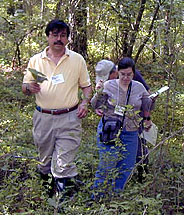
John Mateja
I am an experimental nuclear physicist
with research interests in the area of light heavy-ion reactions. After
earning my B.S and Ph.D. degrees from the University of Notre Dame in
1972 and 1976, I was a post-doctoral research associate at Florida State
University. Subsequent to this appointment, I became a member of the
physics faculty at Tennessee Technological University where I specialized
in teaching introductory calculus-based physics and developed one of
the first research programs involving undergraduates funded by the Department
of Energy's (DOE) Division of Nuclear Physics. In 1988, I joined the
staff at Argonne National Laboratory where I had oversight responsibility
for all faculty, graduate student and undergraduate outreach programs
that placed participants in the research laboratories of Argonne staff.
Approximately 700 college level participants came through this program
annually. In 1994 I was asked to join the staff at DOE headquarters
to co-manage a new grant program to assist non-competitive states to
become more grant competitive for federal research funding. In addition
to soliciting and reviewing grant proposals, site visits were conducted
and grant development workshops were hosted annually. I assumed the
position of Dean of the College of Science, Engineering and Technology
at Murray State University in 1998. In addition to numerous individual
faculty research awards, during my three year tenure as Dean, the College
successfully competed for a $1.5 million Howard Hughes Medical Institute
award, an $800,000 NSF Collaborative Research at Undergraduate Institutions
award and three NSF Course, Curriculum and Laboratory Improvement grants
totaling over $600,000. While final word has not yet been received,
I am optimistic that a $1.5 million NSF Experimental Program to Stimulate
Competitive Research award to support Murray State's environmental science
program will also be received. Today, I am the Director of Murray State's
Undergraduate Research and Scholarly Activity (URSA) office and the
Project Director of the Howard Hughes Medical Institute award. The mission
of the URSA office is to grow undergraduate research and scholarly activity
across the entire campus. For over 15 years, I have been a leader at
the national level of the movement to incorporate undergraduate research
and scholarship into the undergraduate educational experience. I have
been the President of the Council on Undergraduate Research and the
Chair of the American Physical Society's Committee on Education.
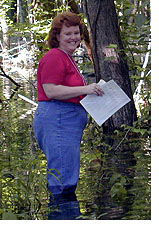
Renee Fister
I am currently an associate professor
of mathematics and statistics at Murray State University. I received
my Ph.D. from the University of Tennessee, Knoxville in 1996 and have
been at Murray State since then. I teach math courses ranging from a
liberal arts math course to graduate partial differential equations.
I have continually tried to use discovery techniques and collaborative
work to enhance my and my students' learning. It has proven fruitful,
and I am still learning how to most effectively use different strategies
to teach mathematics. My research stems from differential equations
with applications in cancer, HIV, and population models. Specifically,
I try to determine the optimal way to give drug treatments or to harvest
a pest in a given population. I have worked with undergraduates on such
problems and have gained so much from them.

Contact
Information University of Oregon for FIRST
Contact Information Murray
State University for FIRST

This project is supported by the National Science Foundation. Opinions expressed are those of the authors and not necessarily those of the Foundation.
| Hancock Biological Station Home Page | College of Science, Engineering and Technology Home Page |
Date Modified February, 2006
Murray State University, College of Science.